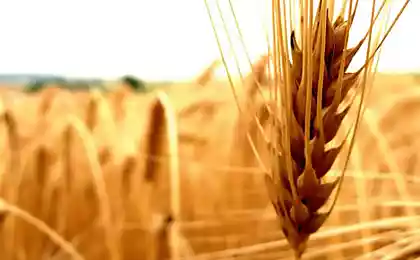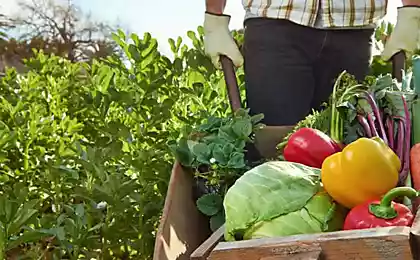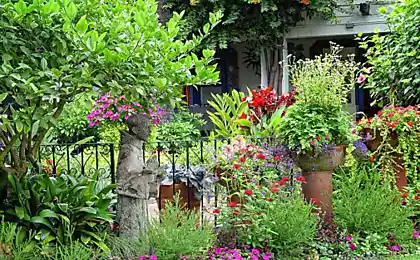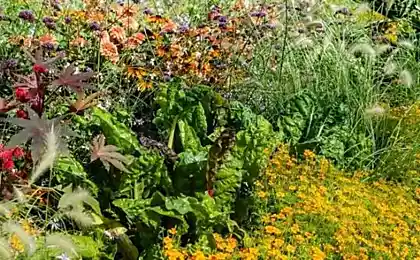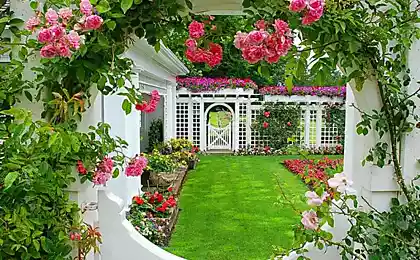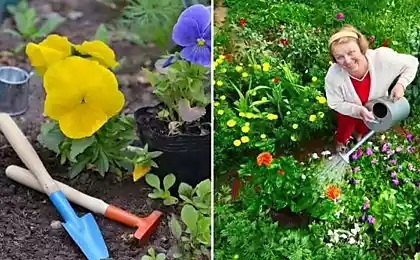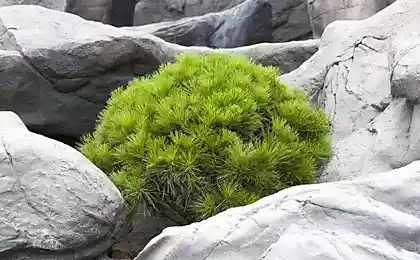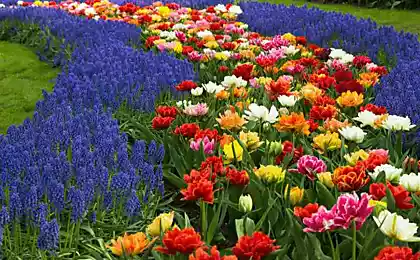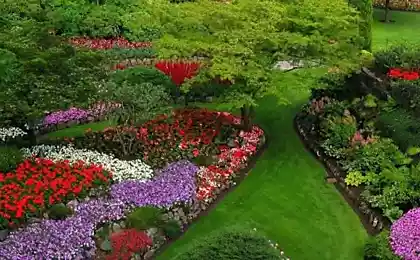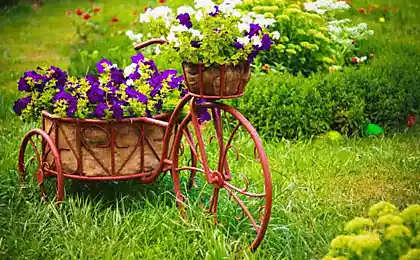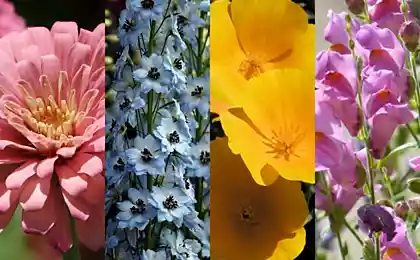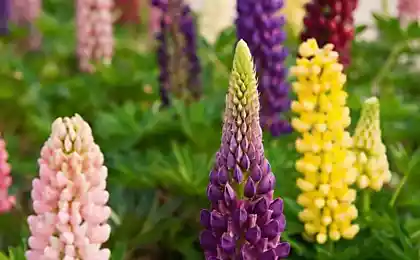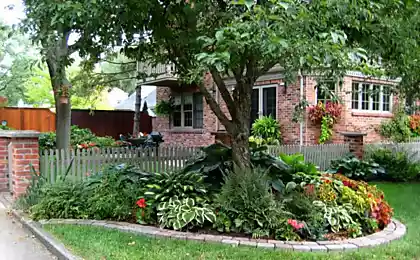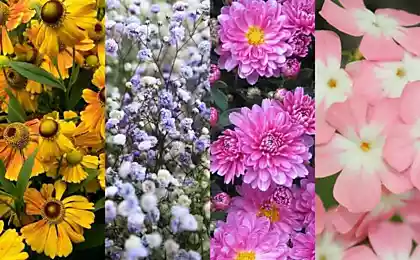413
27 unpretentious flowers for beginner gardeners
The popular phrase about beauty, which requires sacrifices, can be fully attributed to the dacha: in order to make it truly beautiful, gardeners often sacrifice effort, time, money. What if you don’t have enough time or experience, but want beauty? It is nice to relax among the elegant flower beds and flower beds - is it possible only at the cost of titanic efforts? Not at all!
Of course, it will not be easy at all, but decorate your dacha with unpretentious flowers that do not require special hassle either during landing or in care is a very real task. And if you choose the right plants, given their seasonal decorativeness and features of the site, you can realize your dream and from early spring to late autumn enjoy the beauty that does not require special sacrifices.
Since it is bulbous plants that meet spring at the country before all, we will start with them. And believe me, there are many wonderful flowers that will not give you any worries - except that the bulbs need to be protected from the ubiquitous rodents, but for this there are special landing baskets - convenient devices that over time and digging out overgrown bulbs will noticeably simplify.
Timeless
Flowering: August to November (depending on species).
Landing: July or August, to a depth of about 10 cm.
Height: 5-20 cm.
Growing conditions: sun or penumbra; water permeable soil (for a timeless autumn - slightly moist, for other species dry is preferred).
Use in the garden: along bushes, on the lawn, in the mountaineering, in flower gardens; can be grown as a container plant.
This flower got its name for good reason: it is born quite “not in time” – in late autumn, when the leaves from the trees almost flew around, and the garden became completely empty and sad. And then, in the midst of general withering, suddenly these flowers bloom, very reminiscent of crocuses.
Such a late flowering plus exceptional unpretentiousness make the timeless (or colchicums - Latin Colchicum) welcome guests of the garden. Plant them in July-August, choosing sunny areas or places in the penumbra. And then you can forget about any trouble for a long time - timeless people feel much better if they are not disturbed at all. Isn't that a wonderful property?
However, it is worth knowing and considering that this plant (regardless of species and variety) is poisonous. All its parts contain colchicine - a potent poison, so you need to take reasonable care when planting it. Although in my garden, for example, these flowers appeared long before I knew of their possible danger, and are still growing today.
Botanical tulips
Flowering: March to May (depending on species)
Landing: autumn
Height: 10-50 cm (depending on species)
Growing conditions: sunny areas with nutrient permeable soil; it is desirable that in summer it is dry, and in spring - moderately moist, but without stagnation of water.
Use in the garden: group plantings on flower beds and in rabatkas; appropriate in rockariums; very successfully look on the lawn; suitable for growing in pot culture.
They say that botanical tulips are not only blue - all other colors and shades nature gave them. Then the works of breeders were added to this, and today we can admire these charming babies, choosing the shape and color range to your taste.
Unlike other botanical tulips, botanical tulips do not require annual digging of bulbs. You can plant them in a flower garden or among the lawn, and year by year they will only become more spectacular, thanks to the growing nests of bulbs and the abundance of flowers.
In our gardens, the most common tulips are Greig (Tulipa greigii), Kaufman (Tulipa kaufmanniana), Foster (Tulipa fosteriana), as well as late tulip (Tulipa tarda), forest (Tulipa sylvestris) and Turkestan (Tulipa turkestanica).
Due to their small stature, these tulips are suitable for planting in rockariums and mountaineering; they look great on the edge of bushes in natural-style gardens, lawns, but no less spectacular in rabatkas or flowerbeds. They are planted in autumn, like most bulbs, and flowering begins already in April (the earliest are Kaufman, Foster, Turkestan; Greig tulips bloom in late April, forest and late bloom more often in May).
Iridodictiums
Flowering: April, in warm regions - from the end of March.
Landing: from August to the first frost.
Height: 10-15 cm
Growing conditions: open solar areas with light water permeable soil; if the soil is heavy, sand should be added when planting. Neutral or slightly alkaline soil reaction is preferred; wetting, even temporary, is unacceptable.
Use in the garden: excellent plants for rockariums, stony gardens; grow well and feel good under deciduous trees with a light crown; successful planting in groups on the lawn. Iridodictiums are suitable for ejection.
Crocuses
Flowering: March to May, depending on species and variety; there are also species that bloom in autumn.
Planting: spring flowering crocuses are planted in autumn (from August to the first frosts), autumn flowering - in early spring; it is advisable to use special baskets when planting, because crocus bulbs are more often than other small bulbs become prey for rodents.
Height: 7-20 cm
Growing conditions: areas in the sun or in light penumbra (for example, under deciduous trees or shrubs) with permeable soil.
Use in the garden: ideal for rockariums, climbers - groups of flowering crocuses are amazing against the background of stones; successful for planting on the lawn, where elegant lawns soon form; can be used on flower beds and flower beds with perennials; suitable for carving and growing in container culture.
muscari
Flowering: April to June (depending on species and variety)
Planting: August-September; in early summer, after the leaves have completely died off, the overgrown jackets can be divided.
Height: 10-30 cm.
Growing conditions: preferably a warm sunny place, but penumbra is also acceptable; the soil in spring can be moist (without stagnation of water), but at rest the bulbs should be in dry soil. The plant does not tolerate mineral fertilizers, use compost for feeding.
Use in the garden: excellent flowers for planting under deciduous trees and shrubs, in rockariums and stony gardens, on lawns; look great in group plantings in flower beds, in combination with other bulbous ones; muscari are suitable for purging.
These flowers are known to gardeners as a viper onion or mouse hyacinth. About the variety of their species, cultivation and placement in the garden, read the article "Mouse hyacinth" - muscari
Narcissists
Flowering: from April to June (depending on species and variety).
Landing: end of August - September.
Height: 30-60 cm
Growing conditions: areas in the sun or in the penumbra, with loose, fertile, permeable soil without water stagnation.
Use in the garden: successfully used in the design of flower beds, mixboarders and serpents; look good under deciduous trees; can be grown in container culture; suitable for distillation and cutting.
This flower probably needs no introduction - there is hardly a gardener who does not know it. I will note only one curious and useful feature: the bulbs of daffodils do not touch rodents. Moreover, it is believed that they, like grouse, scare away these animals, so it is recommended to plant daffodils around the perimeter of flower beds with other bulbs.
Pushkin
Flowering: April-May.
Landing: end of August - September.
Height: 10-20 cm
Growing conditions: preferably a place where in spring, during the flowering period, the pushkins will be in the sun, and in summer they will be in a light shade (for example, under the crowns of deciduous trees).
Use in the garden: group plantings under trees and shrubs, on lawns; in curbs along garden paths, on flower beds and spring flower beds; the plant is suitable for casting.
Like many other small bulbs, Pushkins like not to be disturbed again, so with a clear conscience you can treat these colors on the principle: "planted - and forgot" :
Hyonodoxy
Flowering: April-May.
Landing: Sept.
Height: 15-25 cm.
Growing conditions: chionodox are relatively undemanding to light: they grow well both in the sun and in light shading; the soil is preferable fertile, well drained; excess moisture is unacceptable.
Use in the garden: very good in rockariums and stony gardens, as, unlike many small bulbs, do not tend to grow violently, capturing space; successful group plantings under trees and shrubs, on lawns; can be used in flower gardens; suitable for carving.
And also unpretentious and quite simple in the cultivation of splashes (scylla), lilies (galanthus), white-flowered.
Perennial plants are remarkable in that you do not need to annually take care of their sowing or growing seedlings. Year after year, they grow and grow. If such a plant, in addition, is undemanding for conditions and care, this is a real find for an inexperienced or busy gardener.
Aquilegia
Flowering: May to August.
Planting: spring (April-May) or autumn (September).
Height: 20-80 cm (depending on species and variety)
Growing conditions: in penumbra; on moist soils, aquilegia can grow under the open sun.
Use in the garden: flower beds and flower beds; stunted species can be used in shady rockariums; these plants look good on the shore of water bodies.
Flowering aquilegias are charming. However, even without flowers, neat bushes with openwork foliage look elegant and expressive, preserving decorativeness all season. Growing aquilegia seedlings is a rather troublesome occupation, but it is easy to purchase ready-made planting material and subsequently quickly multiply the plant.
In early spring or autumn, the overgrown bush is easily divided; delanks (with several buds on each) are immediately planted in a permanent place. If you do not remove the peduncles and allow the seeds to ripen, aquilegia give abundant self-seeds, but in hybrids, the signs of the variety do not persist, and over time you can become the owner of colors of all shades. However, if you do not want to find them in the most unexpected places of your garden, the process is better to keep under control.
astilba
Flowering: from June to September (depending on species and variety).
Planting: spring (April-May) or autumn (September).
Height: 20-120 cm (depending on species and variety).
Growing conditions: penumbra; moist water permeable soil with a high content of organic matter.
Use in the garden: group and single plantings in the rarefied shadow of trees and shrubs, on the banks of reservoirs, in flower beds; compact forms are suitable for container cultivation.
I am sure that if you get acquainted with astilba, you will fall in love with this wonderful plant. It is good in color and has an attractive carved foliage that is spectacular in itself. Selecting plants of different flowering periods, different colors or textures (and inflorescences can be dense or loose, blizzard or penetrating, large or compact), you can create a fantastic flower garden from astilbes alone.
This amazing plant is not touched by pests, it is exceptionally resistant to diseases, and the only thing required for care is pruning of faded inflorescences. In the dry summer, watering may be necessary, but on moist soils this is not necessary. Sometimes it is recommended to shelter plants for the winter, but my astilbs, for example, wintered without shelter - however, here you should focus on the features of the species and climatic conditions.
barvinok
Flowering: April-May
Landing: April-May or August-September
Height: 5-20 cm (ground cover).
Growing conditions: penumbra or shadow - heat and direct sunlight to this plant are contraindicated; the soil is loose, fertile, without stagnation of moisture.
Use in the garden: ground cover plant for shady corners of the garden.
In our gardens, the small pervinka (Vinca minor) is more common, which is found in European forests as a wild plant. On the basis of this species, numerous varieties are derived, differing in various decorative features: some have especially large or terry flowers; others have an unusual color (there are varieties of pervincs with white, red and purple flowers); third have colorful foliage. This type of periwinkle loves moisture and shade.
However, if you have purchased a large periwinkle (Vinca major) or bred on its basis varieties with larger than a small periwinkle, flowers and leaves, keep in mind that this Mediterranean guest prefers warm and dry areas.
Pervinok grows quickly - this must be taken into account when landing. Its long shoots, touching the soil, are easily rooted, and you can easily multiply this plant with cuttings if you wish.
Brunner.
Flowering: from early May.
Landing: Spring (April-May) or August-September.
Height: 30-50 cm
Growing conditions: penumbra; nutritious moist soil; brunnera grows well on clay and loamy soils.
Use in the garden: under trees and shrubs, giving a rarefied shadow; at the foot of fences and walls, along the banks of streams and reservoirs.
The delicate blue brunner flowers in the spring garden create a joyful mood, animate its shady corners. After planting this plant once, you can not worry about it for many years. The only thing is that it is desirable to immediately provide him with more space, since the brunner grows well in favorable conditions.
Breeders bred variegated varieties - with silver or cream-white patterns, spots or border on the leaves. Keep in mind that such plants need protection from sunlight and strong wind - they are more demanding to the conditions than the usual green leaf brunera, which can suffer, perhaps, from drought.
About how to plant a brunner, read and see the material Step by step: plant a brunner
Vasilek is a long-term
Flowering: June to September (depending on species).
Landing: late April – early May or August – September.
Height: 20-100 cm depending on the species and variety.
Growing conditions: most cornflowers prefer sunny places, but some (mountain vasilek and round-headed) grow well in penumbra; soils are undemanding.
Use in the garden: in flower gardens, in combination with other herbaceous perennials.
There are several types of perennial cornflowers, and each of them is good in its own way. Montana (Centaurea montana) has several varietal forms - with white, pink, dark purple and purple lavender flowers. Basilica coarse (Centaurea macrocephala) is distinguished by bright large “wooly” flowers of sun-yellow color.
geran
Flowering: May to August (depending on species and variety).
Landing: April-May.
Height: 10-100 cm (depending on species and variety).
Growing conditions: geraniums are very diverse, and you can choose a plant for almost any conditions, both in lighting and soil types.
Garden use: all types of geranium grow well along shrubbery plantings, in light penumbra; it is an excellent flowerbed plant; short-sized species are used in curbs and as cover plants; some species are suitable for stony gardens and rockarias.
In my garden for a long time settled wild species, which you can read in the article Forest and field plants in the garden: geranium. Interesting information you will find in the article Geran large-rooted, or healthy. And whatever kind of plant you choose, geranium will not require you to pay attention to your person, but will give, despite this, bright flowering. The geranium bushes, thanks to their spectacular foliage, are decorative all season. And this plant is practically not sick, and pests do not encroach on it.
derbennik
Flowering: July to September
Landing: April-May or August-September
Height: 60-140 cm
Growing conditions: the ideal option is a wet area in the shade in the afternoon; derbennik can grow even on very heavy soils; tolerates short-term flooding, needs good soil moisture.
Use in the garden: suitable for planting in low-lying, wetlands; looks great on the banks of water bodies; can be used in rattles and mixboarders, provided there is enough moisture in the soil.
Having planted this plant in your garden, you can be sure that it will not go unnoticed. Read more about its planting and cultivation in the article The flowering time of the derbennik
doronicum
Flowering: May-June.
Landing: April-May.
Height: 30-80 cm (depending on species)
Growing conditions: sun or penumbra; water permeable nutrient soil
Use in the garden: spring flower beds and flower beds; successful placement of the Doronicum on the edge of the bushes.
Sunny mood is ensured when doronicum blooms! These bright flowers, similar to chamomile, are very spectacular in flower gardens, because at the time of flowering of the Doronicum, most garden plants are still gaining strength, and bulbous ones already fade.
When planting, note: at the end of flowering, most doronicums wither - they begin a period of rest. At this time, strongly growing bushes can be divided and transplanted. If you plant doronicum on a flowerbed, combine it with perennial or annual plants that can hide withering foliage in early summer.
Bathroom
Flowering: from April to August - depending on the variety; more often - May.
Landing: April-May
Height: 50-90 cm
Growing conditions: a plot in the sun or in the penumbra, with well moistened soil; hot and dry places with loose lime or sandy soil are not suitable for planting.
Use in the garden: design of the coastal zone of reservoirs, streams; humid half-shaded corners of the garden; successful location of swimsuits along bushes, walls and fences.
On sale you can easily find the planting material of hybrid swimsuits, the flowers of which have different shades of yellow or orange. Less common is the Chinese swimsuit - a high (up to 1 m) late flowering (June-August) plant.
Kupena
Flowering: May-June
Landing: April-May or September.
Height: 30-100 cm (depending on species)
Growing conditions: this plant is for shady and semi-shady areas; on moist soil, the sun also carries.
Use in the garden: design of shady areas, group plantings on the outskirts of wood and shrubs, under trees.
A feature of all types of coupéna are elegant stems with numerous white drooping flowers, similar to small bells. Read more about the coupe in interesting material Ideas for flower beds in the shade. Kupena
Labaznik
Flowering: June-September (depending on species)
Landing: May
Height: 30-250 cm (depending on species and variety)
Growing conditions: Labaznik grows both in the sun and in the penumbra, but the soil must necessarily be moist; heavy clay soils with a high humus content are preferred.
Use in the garden: spectacular plant for the coastal zone of reservoirs and streams; labaznik knasolous (or tavolga) can grow on wetlands, and labaznik ordinary is suitable for rockariums or workers with lime soil.
Read more about how to use a labazanik in the garden, read in article 2 labazaniks for giving and all about them. And about a wonderful plant, in a wild form found throughout the European part of Russia, and can become a decoration of your garden, tells the article Forest and field plants in the garden: tavolga vyazolous
lupin
Flowering: June-July; re-flowering - August-September
Landing: April-May
Height: 80-100 cm
Growing conditions: sun; permeable, slightly acidic soil; lupins do not like lime and highly fertilized soils.
Use in the garden: lupins are an integral attribute of a rural garden; they are great for workers with herbaceous perennials and flower beds.
Note: lupin seeds contain poisonous substances, so peduncles should be pruned in time. But for that little effort, you'll be rewarded with repeated autumn blooms. Read more about planting and growing this plant in the article Lupin - a lush decoration of the garden
petal
Flowering: June to September
Landing: May
Height: 20-80 cm (depending on species and variety)
Growing conditions: The best option is open solar areas with nutritious loose soil.
Use in the garden: flower beds and flower beds in sunny areas.
Small petal is remarkable for its long and abundant flowering, and care for it consists only in installing props for tall varieties - they tend to fall apart, especially in rainy weather. Yes, and keep in mind: small petal hybrid, or erigeron, is a rather aggressive plant; once in favorable conditions, it actively grows and can capture vast spaces, so it is better to immediately limit its growth.
enoter
Flowering: June to September (depending on species)
Landing: April or September
Height: 15-100 cm (depending on species and variety)
Growing conditions: sunny areas with rather poor soil; phenotheras tolerate drought well, although with moderate moisture they bloom longer.
Garden use: Enotera is a great plant for flower beds and mixed flower beds; some species are suitable for rocky and gravel gardens and rockarias.
More useful information about this plant you will find in the article Enothera - mysterious and controversial and comments on it.
It is worth planting in the garden and such unpretentious plants as goldenrod, catfish, honeycomb, some types of milkweed.
Despite the fact that most annuals are grown by seedling method, that is, still requires some hassle, there are also those in this group of plants that are loved by gardeners precisely for their unpretentiousness, ease of cultivation and care.
viola
Flowering: from April to frost
Planting: the plant perfectly tolerates transplantation, even flowering, so you can plant violas all season; in spring you can cut last year's plants (for how this is done, read here)
Height: 15-30 cm
Growing conditions: a site with permeable nutrient soil, in the sun or in the penumbra.
Use in the garden: Violas are exceptionally versatile, they can be grown in the garden almost anywhere - from rockariae to lawn, from flower beds to containers and ampelas.
In the spring, buy seedlings of viola - it is sold by many garden centers, and you can buy quality plants on the market - and create luxury flower gardens that will delight you all summer.
Read more about violas in the article Viola - the favorite granddaughter of violet and publications Charming eyes.
Turkish carnation
Flowering: June-September
Planting: Turkish cloves are propagated by sowing on seedlings (in April) or in the ground (early spring or in winter).
Height: 40-60 cm
Growing conditions: sun or light penumbra, loose water permeable soil.
Use in the garden: Turkish carnation is a great plant for flower gardens in rural style
This plant is considered a biennial, but by sowing it once, you can admire the flowers for many years, because the Turkish carnation reproduces wonderfully by self-seeding. Just do not prune flower-noses with withering flowers - let it form and spread seeds.
About this wonderful plant and the experience of growing it, you can read in the post Why I love Turkish carnation
calendula
Flowering: from June to frost
Planting: sow the calendula in April-May in the soil directly in the flower garden.
Height: 20-70 cm (depending on variety)
Growing conditions: preferably sun, but calendula can grow in the penumbra; soil - any, except dry sandy or excessively moist.
Use in the garden: Calendula is a versatile plant that can be used in the garden everywhere, as well as grown on balconies and terraces in container culture.
Nasturtia
Flowering: from June to frost
Planting: sowing in the ground at the end of May
Height: 30-300 cm (curly)
Growing conditions: solar areas protected from strong wind with water permeable soil are preferred.
Use in the garden: Nasturtia looks amazing in the trunk circles of trees, under shrubs, along fences and walls; it can be used as a ground cover or ampel plant. Read about this flower in the publication Nasturtius: beauty, benefits and protection
phacelia
Flowering: June-September
Planting: sow phacelia in the soil throughout the season; for flowering - in May, as a siderate - until September inclusive.
Height: 20-90 cm (depending on species)
Growing conditions: sunny areas or light penumbra, light garden soil.
Use in the garden: phacelia can be sown in any planting-free areas of the garden - it will decorate them and enrich the soil. This is not only a beautiful plant with carved openwork foliage and charming delicate flowers, but also an excellent siderate, and a honey plant that attracts insects to your garden.
And you can also settle in your garden daisies and forget-me-nots, annual cornflowers and linen, velvets and many other flowers.
As you can see, plants that allow you to create a beautiful garden without sacrifices are not enough, because this list can still be supplemented and expanded. Perhaps you have your favorites – tell us about them in the comments!
Source: www.7dach.ru
Of course, it will not be easy at all, but decorate your dacha with unpretentious flowers that do not require special hassle either during landing or in care is a very real task. And if you choose the right plants, given their seasonal decorativeness and features of the site, you can realize your dream and from early spring to late autumn enjoy the beauty that does not require special sacrifices.
Since it is bulbous plants that meet spring at the country before all, we will start with them. And believe me, there are many wonderful flowers that will not give you any worries - except that the bulbs need to be protected from the ubiquitous rodents, but for this there are special landing baskets - convenient devices that over time and digging out overgrown bulbs will noticeably simplify.
Timeless
Flowering: August to November (depending on species).
Landing: July or August, to a depth of about 10 cm.
Height: 5-20 cm.
Growing conditions: sun or penumbra; water permeable soil (for a timeless autumn - slightly moist, for other species dry is preferred).
Use in the garden: along bushes, on the lawn, in the mountaineering, in flower gardens; can be grown as a container plant.
This flower got its name for good reason: it is born quite “not in time” – in late autumn, when the leaves from the trees almost flew around, and the garden became completely empty and sad. And then, in the midst of general withering, suddenly these flowers bloom, very reminiscent of crocuses.
Such a late flowering plus exceptional unpretentiousness make the timeless (or colchicums - Latin Colchicum) welcome guests of the garden. Plant them in July-August, choosing sunny areas or places in the penumbra. And then you can forget about any trouble for a long time - timeless people feel much better if they are not disturbed at all. Isn't that a wonderful property?
However, it is worth knowing and considering that this plant (regardless of species and variety) is poisonous. All its parts contain colchicine - a potent poison, so you need to take reasonable care when planting it. Although in my garden, for example, these flowers appeared long before I knew of their possible danger, and are still growing today.
Botanical tulips
Flowering: March to May (depending on species)
Landing: autumn
Height: 10-50 cm (depending on species)
Growing conditions: sunny areas with nutrient permeable soil; it is desirable that in summer it is dry, and in spring - moderately moist, but without stagnation of water.
Use in the garden: group plantings on flower beds and in rabatkas; appropriate in rockariums; very successfully look on the lawn; suitable for growing in pot culture.
They say that botanical tulips are not only blue - all other colors and shades nature gave them. Then the works of breeders were added to this, and today we can admire these charming babies, choosing the shape and color range to your taste.
Unlike other botanical tulips, botanical tulips do not require annual digging of bulbs. You can plant them in a flower garden or among the lawn, and year by year they will only become more spectacular, thanks to the growing nests of bulbs and the abundance of flowers.
In our gardens, the most common tulips are Greig (Tulipa greigii), Kaufman (Tulipa kaufmanniana), Foster (Tulipa fosteriana), as well as late tulip (Tulipa tarda), forest (Tulipa sylvestris) and Turkestan (Tulipa turkestanica).
Due to their small stature, these tulips are suitable for planting in rockariums and mountaineering; they look great on the edge of bushes in natural-style gardens, lawns, but no less spectacular in rabatkas or flowerbeds. They are planted in autumn, like most bulbs, and flowering begins already in April (the earliest are Kaufman, Foster, Turkestan; Greig tulips bloom in late April, forest and late bloom more often in May).
Iridodictiums
Flowering: April, in warm regions - from the end of March.
Landing: from August to the first frost.
Height: 10-15 cm
Growing conditions: open solar areas with light water permeable soil; if the soil is heavy, sand should be added when planting. Neutral or slightly alkaline soil reaction is preferred; wetting, even temporary, is unacceptable.
Use in the garden: excellent plants for rockariums, stony gardens; grow well and feel good under deciduous trees with a light crown; successful planting in groups on the lawn. Iridodictiums are suitable for ejection.
Crocuses
Flowering: March to May, depending on species and variety; there are also species that bloom in autumn.
Planting: spring flowering crocuses are planted in autumn (from August to the first frosts), autumn flowering - in early spring; it is advisable to use special baskets when planting, because crocus bulbs are more often than other small bulbs become prey for rodents.
Height: 7-20 cm
Growing conditions: areas in the sun or in light penumbra (for example, under deciduous trees or shrubs) with permeable soil.
Use in the garden: ideal for rockariums, climbers - groups of flowering crocuses are amazing against the background of stones; successful for planting on the lawn, where elegant lawns soon form; can be used on flower beds and flower beds with perennials; suitable for carving and growing in container culture.
muscari
Flowering: April to June (depending on species and variety)
Planting: August-September; in early summer, after the leaves have completely died off, the overgrown jackets can be divided.
Height: 10-30 cm.
Growing conditions: preferably a warm sunny place, but penumbra is also acceptable; the soil in spring can be moist (without stagnation of water), but at rest the bulbs should be in dry soil. The plant does not tolerate mineral fertilizers, use compost for feeding.
Use in the garden: excellent flowers for planting under deciduous trees and shrubs, in rockariums and stony gardens, on lawns; look great in group plantings in flower beds, in combination with other bulbous ones; muscari are suitable for purging.
These flowers are known to gardeners as a viper onion or mouse hyacinth. About the variety of their species, cultivation and placement in the garden, read the article "Mouse hyacinth" - muscari
Narcissists
Flowering: from April to June (depending on species and variety).
Landing: end of August - September.
Height: 30-60 cm
Growing conditions: areas in the sun or in the penumbra, with loose, fertile, permeable soil without water stagnation.
Use in the garden: successfully used in the design of flower beds, mixboarders and serpents; look good under deciduous trees; can be grown in container culture; suitable for distillation and cutting.
This flower probably needs no introduction - there is hardly a gardener who does not know it. I will note only one curious and useful feature: the bulbs of daffodils do not touch rodents. Moreover, it is believed that they, like grouse, scare away these animals, so it is recommended to plant daffodils around the perimeter of flower beds with other bulbs.
Pushkin
Flowering: April-May.
Landing: end of August - September.
Height: 10-20 cm
Growing conditions: preferably a place where in spring, during the flowering period, the pushkins will be in the sun, and in summer they will be in a light shade (for example, under the crowns of deciduous trees).
Use in the garden: group plantings under trees and shrubs, on lawns; in curbs along garden paths, on flower beds and spring flower beds; the plant is suitable for casting.
Like many other small bulbs, Pushkins like not to be disturbed again, so with a clear conscience you can treat these colors on the principle: "planted - and forgot" :
Hyonodoxy
Flowering: April-May.
Landing: Sept.
Height: 15-25 cm.
Growing conditions: chionodox are relatively undemanding to light: they grow well both in the sun and in light shading; the soil is preferable fertile, well drained; excess moisture is unacceptable.
Use in the garden: very good in rockariums and stony gardens, as, unlike many small bulbs, do not tend to grow violently, capturing space; successful group plantings under trees and shrubs, on lawns; can be used in flower gardens; suitable for carving.
And also unpretentious and quite simple in the cultivation of splashes (scylla), lilies (galanthus), white-flowered.
Perennial plants are remarkable in that you do not need to annually take care of their sowing or growing seedlings. Year after year, they grow and grow. If such a plant, in addition, is undemanding for conditions and care, this is a real find for an inexperienced or busy gardener.
Aquilegia
Flowering: May to August.
Planting: spring (April-May) or autumn (September).
Height: 20-80 cm (depending on species and variety)
Growing conditions: in penumbra; on moist soils, aquilegia can grow under the open sun.
Use in the garden: flower beds and flower beds; stunted species can be used in shady rockariums; these plants look good on the shore of water bodies.
Flowering aquilegias are charming. However, even without flowers, neat bushes with openwork foliage look elegant and expressive, preserving decorativeness all season. Growing aquilegia seedlings is a rather troublesome occupation, but it is easy to purchase ready-made planting material and subsequently quickly multiply the plant.
In early spring or autumn, the overgrown bush is easily divided; delanks (with several buds on each) are immediately planted in a permanent place. If you do not remove the peduncles and allow the seeds to ripen, aquilegia give abundant self-seeds, but in hybrids, the signs of the variety do not persist, and over time you can become the owner of colors of all shades. However, if you do not want to find them in the most unexpected places of your garden, the process is better to keep under control.
astilba
Flowering: from June to September (depending on species and variety).
Planting: spring (April-May) or autumn (September).
Height: 20-120 cm (depending on species and variety).
Growing conditions: penumbra; moist water permeable soil with a high content of organic matter.
Use in the garden: group and single plantings in the rarefied shadow of trees and shrubs, on the banks of reservoirs, in flower beds; compact forms are suitable for container cultivation.
I am sure that if you get acquainted with astilba, you will fall in love with this wonderful plant. It is good in color and has an attractive carved foliage that is spectacular in itself. Selecting plants of different flowering periods, different colors or textures (and inflorescences can be dense or loose, blizzard or penetrating, large or compact), you can create a fantastic flower garden from astilbes alone.
This amazing plant is not touched by pests, it is exceptionally resistant to diseases, and the only thing required for care is pruning of faded inflorescences. In the dry summer, watering may be necessary, but on moist soils this is not necessary. Sometimes it is recommended to shelter plants for the winter, but my astilbs, for example, wintered without shelter - however, here you should focus on the features of the species and climatic conditions.
barvinok
Flowering: April-May
Landing: April-May or August-September
Height: 5-20 cm (ground cover).
Growing conditions: penumbra or shadow - heat and direct sunlight to this plant are contraindicated; the soil is loose, fertile, without stagnation of moisture.
Use in the garden: ground cover plant for shady corners of the garden.
In our gardens, the small pervinka (Vinca minor) is more common, which is found in European forests as a wild plant. On the basis of this species, numerous varieties are derived, differing in various decorative features: some have especially large or terry flowers; others have an unusual color (there are varieties of pervincs with white, red and purple flowers); third have colorful foliage. This type of periwinkle loves moisture and shade.
However, if you have purchased a large periwinkle (Vinca major) or bred on its basis varieties with larger than a small periwinkle, flowers and leaves, keep in mind that this Mediterranean guest prefers warm and dry areas.
Pervinok grows quickly - this must be taken into account when landing. Its long shoots, touching the soil, are easily rooted, and you can easily multiply this plant with cuttings if you wish.
Brunner.
Flowering: from early May.
Landing: Spring (April-May) or August-September.
Height: 30-50 cm
Growing conditions: penumbra; nutritious moist soil; brunnera grows well on clay and loamy soils.
Use in the garden: under trees and shrubs, giving a rarefied shadow; at the foot of fences and walls, along the banks of streams and reservoirs.
The delicate blue brunner flowers in the spring garden create a joyful mood, animate its shady corners. After planting this plant once, you can not worry about it for many years. The only thing is that it is desirable to immediately provide him with more space, since the brunner grows well in favorable conditions.
Breeders bred variegated varieties - with silver or cream-white patterns, spots or border on the leaves. Keep in mind that such plants need protection from sunlight and strong wind - they are more demanding to the conditions than the usual green leaf brunera, which can suffer, perhaps, from drought.
About how to plant a brunner, read and see the material Step by step: plant a brunner
Vasilek is a long-term
Flowering: June to September (depending on species).
Landing: late April – early May or August – September.
Height: 20-100 cm depending on the species and variety.
Growing conditions: most cornflowers prefer sunny places, but some (mountain vasilek and round-headed) grow well in penumbra; soils are undemanding.
Use in the garden: in flower gardens, in combination with other herbaceous perennials.
There are several types of perennial cornflowers, and each of them is good in its own way. Montana (Centaurea montana) has several varietal forms - with white, pink, dark purple and purple lavender flowers. Basilica coarse (Centaurea macrocephala) is distinguished by bright large “wooly” flowers of sun-yellow color.
geran
Flowering: May to August (depending on species and variety).
Landing: April-May.
Height: 10-100 cm (depending on species and variety).
Growing conditions: geraniums are very diverse, and you can choose a plant for almost any conditions, both in lighting and soil types.
Garden use: all types of geranium grow well along shrubbery plantings, in light penumbra; it is an excellent flowerbed plant; short-sized species are used in curbs and as cover plants; some species are suitable for stony gardens and rockarias.
In my garden for a long time settled wild species, which you can read in the article Forest and field plants in the garden: geranium. Interesting information you will find in the article Geran large-rooted, or healthy. And whatever kind of plant you choose, geranium will not require you to pay attention to your person, but will give, despite this, bright flowering. The geranium bushes, thanks to their spectacular foliage, are decorative all season. And this plant is practically not sick, and pests do not encroach on it.
derbennik
Flowering: July to September
Landing: April-May or August-September
Height: 60-140 cm
Growing conditions: the ideal option is a wet area in the shade in the afternoon; derbennik can grow even on very heavy soils; tolerates short-term flooding, needs good soil moisture.
Use in the garden: suitable for planting in low-lying, wetlands; looks great on the banks of water bodies; can be used in rattles and mixboarders, provided there is enough moisture in the soil.
Having planted this plant in your garden, you can be sure that it will not go unnoticed. Read more about its planting and cultivation in the article The flowering time of the derbennik
doronicum
Flowering: May-June.
Landing: April-May.
Height: 30-80 cm (depending on species)
Growing conditions: sun or penumbra; water permeable nutrient soil
Use in the garden: spring flower beds and flower beds; successful placement of the Doronicum on the edge of the bushes.
Sunny mood is ensured when doronicum blooms! These bright flowers, similar to chamomile, are very spectacular in flower gardens, because at the time of flowering of the Doronicum, most garden plants are still gaining strength, and bulbous ones already fade.
When planting, note: at the end of flowering, most doronicums wither - they begin a period of rest. At this time, strongly growing bushes can be divided and transplanted. If you plant doronicum on a flowerbed, combine it with perennial or annual plants that can hide withering foliage in early summer.
Bathroom
Flowering: from April to August - depending on the variety; more often - May.
Landing: April-May
Height: 50-90 cm
Growing conditions: a plot in the sun or in the penumbra, with well moistened soil; hot and dry places with loose lime or sandy soil are not suitable for planting.
Use in the garden: design of the coastal zone of reservoirs, streams; humid half-shaded corners of the garden; successful location of swimsuits along bushes, walls and fences.
On sale you can easily find the planting material of hybrid swimsuits, the flowers of which have different shades of yellow or orange. Less common is the Chinese swimsuit - a high (up to 1 m) late flowering (June-August) plant.
Kupena
Flowering: May-June
Landing: April-May or September.
Height: 30-100 cm (depending on species)
Growing conditions: this plant is for shady and semi-shady areas; on moist soil, the sun also carries.
Use in the garden: design of shady areas, group plantings on the outskirts of wood and shrubs, under trees.
A feature of all types of coupéna are elegant stems with numerous white drooping flowers, similar to small bells. Read more about the coupe in interesting material Ideas for flower beds in the shade. Kupena
Labaznik
Flowering: June-September (depending on species)
Landing: May
Height: 30-250 cm (depending on species and variety)
Growing conditions: Labaznik grows both in the sun and in the penumbra, but the soil must necessarily be moist; heavy clay soils with a high humus content are preferred.
Use in the garden: spectacular plant for the coastal zone of reservoirs and streams; labaznik knasolous (or tavolga) can grow on wetlands, and labaznik ordinary is suitable for rockariums or workers with lime soil.
Read more about how to use a labazanik in the garden, read in article 2 labazaniks for giving and all about them. And about a wonderful plant, in a wild form found throughout the European part of Russia, and can become a decoration of your garden, tells the article Forest and field plants in the garden: tavolga vyazolous
lupin
Flowering: June-July; re-flowering - August-September
Landing: April-May
Height: 80-100 cm
Growing conditions: sun; permeable, slightly acidic soil; lupins do not like lime and highly fertilized soils.
Use in the garden: lupins are an integral attribute of a rural garden; they are great for workers with herbaceous perennials and flower beds.
Note: lupin seeds contain poisonous substances, so peduncles should be pruned in time. But for that little effort, you'll be rewarded with repeated autumn blooms. Read more about planting and growing this plant in the article Lupin - a lush decoration of the garden
petal
Flowering: June to September
Landing: May
Height: 20-80 cm (depending on species and variety)
Growing conditions: The best option is open solar areas with nutritious loose soil.
Use in the garden: flower beds and flower beds in sunny areas.
Small petal is remarkable for its long and abundant flowering, and care for it consists only in installing props for tall varieties - they tend to fall apart, especially in rainy weather. Yes, and keep in mind: small petal hybrid, or erigeron, is a rather aggressive plant; once in favorable conditions, it actively grows and can capture vast spaces, so it is better to immediately limit its growth.
enoter
Flowering: June to September (depending on species)
Landing: April or September
Height: 15-100 cm (depending on species and variety)
Growing conditions: sunny areas with rather poor soil; phenotheras tolerate drought well, although with moderate moisture they bloom longer.
Garden use: Enotera is a great plant for flower beds and mixed flower beds; some species are suitable for rocky and gravel gardens and rockarias.
More useful information about this plant you will find in the article Enothera - mysterious and controversial and comments on it.
It is worth planting in the garden and such unpretentious plants as goldenrod, catfish, honeycomb, some types of milkweed.
Despite the fact that most annuals are grown by seedling method, that is, still requires some hassle, there are also those in this group of plants that are loved by gardeners precisely for their unpretentiousness, ease of cultivation and care.
viola
Flowering: from April to frost
Planting: the plant perfectly tolerates transplantation, even flowering, so you can plant violas all season; in spring you can cut last year's plants (for how this is done, read here)
Height: 15-30 cm
Growing conditions: a site with permeable nutrient soil, in the sun or in the penumbra.
Use in the garden: Violas are exceptionally versatile, they can be grown in the garden almost anywhere - from rockariae to lawn, from flower beds to containers and ampelas.
In the spring, buy seedlings of viola - it is sold by many garden centers, and you can buy quality plants on the market - and create luxury flower gardens that will delight you all summer.
Read more about violas in the article Viola - the favorite granddaughter of violet and publications Charming eyes.
Turkish carnation
Flowering: June-September
Planting: Turkish cloves are propagated by sowing on seedlings (in April) or in the ground (early spring or in winter).
Height: 40-60 cm
Growing conditions: sun or light penumbra, loose water permeable soil.
Use in the garden: Turkish carnation is a great plant for flower gardens in rural style
This plant is considered a biennial, but by sowing it once, you can admire the flowers for many years, because the Turkish carnation reproduces wonderfully by self-seeding. Just do not prune flower-noses with withering flowers - let it form and spread seeds.
About this wonderful plant and the experience of growing it, you can read in the post Why I love Turkish carnation
calendula
Flowering: from June to frost
Planting: sow the calendula in April-May in the soil directly in the flower garden.
Height: 20-70 cm (depending on variety)
Growing conditions: preferably sun, but calendula can grow in the penumbra; soil - any, except dry sandy or excessively moist.
Use in the garden: Calendula is a versatile plant that can be used in the garden everywhere, as well as grown on balconies and terraces in container culture.
Nasturtia
Flowering: from June to frost
Planting: sowing in the ground at the end of May
Height: 30-300 cm (curly)
Growing conditions: solar areas protected from strong wind with water permeable soil are preferred.
Use in the garden: Nasturtia looks amazing in the trunk circles of trees, under shrubs, along fences and walls; it can be used as a ground cover or ampel plant. Read about this flower in the publication Nasturtius: beauty, benefits and protection
phacelia
Flowering: June-September
Planting: sow phacelia in the soil throughout the season; for flowering - in May, as a siderate - until September inclusive.
Height: 20-90 cm (depending on species)
Growing conditions: sunny areas or light penumbra, light garden soil.
Use in the garden: phacelia can be sown in any planting-free areas of the garden - it will decorate them and enrich the soil. This is not only a beautiful plant with carved openwork foliage and charming delicate flowers, but also an excellent siderate, and a honey plant that attracts insects to your garden.
And you can also settle in your garden daisies and forget-me-nots, annual cornflowers and linen, velvets and many other flowers.
As you can see, plants that allow you to create a beautiful garden without sacrifices are not enough, because this list can still be supplemented and expanded. Perhaps you have your favorites – tell us about them in the comments!
Source: www.7dach.ru
The rules of growing spinach in pots on the windowsill
How to carry out disinfection of seeds before sowing?
